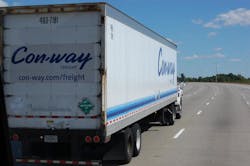The recent earnings report from TL giant Werner Enterprises illustrates some of those trends, with the Omaha, NE-based carrier posting strong third quarter profits compared to 2013, though its year-to-date fiscal earnings are more modest.
Werner generated over $334.5 million in trucking revenue net of fuel surcharges in the third quarter this year – up 4% versus the same period in 2013 – with net income topping $25.9 million, some 22% higher versus the third quarter last year.
Year-to-date, though, Werner’s trucking revenues net of fuel surcharges jumped just 2% to $978 million versus the same stretch last year, with net income also up just 2% to over $65.9 million versus the same period in 2013.
Yet the company sees no signs that freight demand will be slacking off anytime soon, which is helping not only keep its trucks busy but extending length of hauls as well – something of a double-edged sword, though, as we shall see.
Freight demand showed consistent strength, and we were overbooked throughout third quarter 2014,” Werner noted in its earnings report. “Freight market dynamics began showing year-over-year improvement in mid-November 2013 and that favorable trend has continued for the last eleven months, including the first three weeks of October.”
Tight capacity market combined with a gradually firming economy main the primary contributing factors behind this freight uptick and Werner fully expects this favorable demand trend relative to constrained supply to continue.
The company also noted that its average revenues per tractor per week, net of fuel surcharge, increased 7.4% in third quarter this year compared to last year, with average miles per truck ticking up 5.3% to further help reduce Werner’s empty miles percentage by 2.2%.
However, the carrier said its average trip length increased by 6.7% in third quarter this year and longer lengths of haul generally translate into a lower rate-per-mile – and thus less money for its pockets – due to productivity benefits.
Werner also noted that lower diesel fuel prices helped its bottom line tremendously, too, as diesel averaged out to be some 20 cents per gallon lower in third quarter this year versus the same period in 2013 – after trending down 16 cents per gallon lower back in the second quarter.
“For the first 20 days of October, the average diesel fuel price per gallon was 37 cents lower than the average diesel fuel price per gallon in the same period of 2013 and 34 cents lower than in fourth quarter 2013,” the carrier added.Such positive factors are also filling the sails of LTL carriers, though not as much as their TL brethren, as some analysis issued by David Ross with Wall Street investment firm Stifel Nicolaus & Co. last week indicates.
“In our view, year-over-year growth rates in [LTL] pricing and tonnage should decelerate in the fourth quarter before seasonal softness in the first quarter 2015 likely challenges rates further,” he said. “Those assumptions are already premised on a winter with fewer network disruptions than the immediate past one.”
Nearer-term, Ross had hoped that October would continue the solid momentum from this summer in terms of LTL tonnage growth and pricing, but reports from mid-September regarding freight softening caused the firm to reconsider its forecast to a degree.
“Still, with continued tightness in truck capacity, assuming that the relatively-consolidated LTL space remains disciplined on pricing and that the industrial economy remains stable, the wind should remain at the back of LTL margins for the next couple years,” Ross added.
Here are a few LTL market specifics to consider:
- Despite strong LTL volumes through the third quarter, Stifel expects tonnage growth to flatten and/or soften once data from the first few weeks of October is compiled. Still, shipment levels should remain in positive territory through year-end, the firm predicts.
- LTL pricing continues to move higher, but it is no longer accelerating. The GRIs [general rate increases] implemented over the summer are already being discounted back. In addition, reported yields are likely to fall short of actual rate increases, as average weight per shipment is growing due to TL overflow.
- Though organized labor has re-emerged as a hot topic in the LTL space after workers voted to organize at one Con-way Freight facility and one FedEx Freight facility, Stifel believes such “unionization” will be contained as unions have been losing members in LTL for decades. Now that the Teamsters have a foot in the door of two of their top targets, though, Stifel thinks they’ll fight hard to bring the vote to more terminals.
- Wage pressure remains still largely a TL issue. Moreover, the LTL industry still pays its drivers significantly more than the truckload industry, which is where we expect significant pay increases to continue.
- Declining diesel fuel prices are actually expected to pinch LTL margins slightly in the third and fourth quarters this year as LTL pricing decisions are now generally made on an "all-in" basis. However, newer tractors, which are more fuel-efficient, may help offset some of the pressure for carriers lowering their average fleet age this year.
Yet more diversified carriers, despite facing a host of similar challenges, seem to be making bigger gains in terms of revenues and profits.
For example, J.B. Hunt Transport Services – which is more focused on dedicated contract carriage (DCC) and intermodal offerings now than in the past – pulled in $102.4 million in earnings on top of $1.6 billion in revenues for the third quarter this year, compared to $89.5 million and $1.44 billion, respectively, in the third quarter of 2013.
Load growth within its intermodal division, improved asset productivity and implemented rate increases in DCC and an increase in both load volume and revenue per load within its integrated capacity solutions (ICS) operation helped drive 8%, 13% and 35% increases in segment revenue, respectively, during the third quarter this year.
Indeed, only J.B. Hunt’s TL operation witnessed a revenue decrease, though just a small one at 1%, primarily due to its 6% smaller fleet.Yet the carrier remains well aware of the still-present challenges facing the industry, especially the driver shortage, which it highlighted in a white paper issued back in September.
“Industry insiders and analysts alike have forewarned of a looming driver shortage since the last recession,” J.B. Hunt noted in the paper, pointed to American Trucking Associations (ATA) data that indicates roughly 96,000 new drivers are required annually to keep pace with freight demand.
“If freight demand grows as expected, the annual driver shortage could balloon to nearly 240,000 by 2022,” the carrier stressed. “There are many contributing factors, including an aging workforce, new and tightening regulations, and a need for increased capacity during our current economic upturn.”
Yet J.B. Hunt also believes the trucking market will stay “near the tipping point” because of the strength of freight demand.
“At best, seasonal peaks and any event which swells demand or degrades capacity will cause a series of short capacity crises,” the carrier stressed, adding that current capacity trends are holding at 98%.
“Another wave of regulations will likely hit in 2016, potentially creating capacity concerns, thus making cooperative carrier relationships highly necessary,” J.B. Hunt noted.
In the end, though, with capacity projected to stay tight if not tighten further, carriers should continue to maintain the whip hand when it comes to getting rates needed to afford higher driver wages, more expensive yet more fuel efficient equipment, etc.
That’s a big positive factor that should stay green for some time to come.






